Analyzing Seven Eleven's Logistics: Strategy, Risks, and Performance
VerifiedAdded on 2023/06/18
|9
|3009
|462
Case Study
AI Summary
This case study provides a detailed analysis of Seven Eleven's logistics strategy, focusing on its supply network design, warehousing, order management, and transportation choices. It highlights how the company's logistics strategy is built on trust, cost-effectiveness, and demand-oriented approaches. The analysis covers Seven-Eleven's supply network design, emphasizing direct communication between production, distribution centers, and retailers to minimize waste. The study also examines warehousing practices, order management efficiency through technological integration, and the use of combined delivery systems with temperature-controlled trucks. Furthermore, it assesses logistics performance measures, potential risks such as strategic, market, implementation, and demand risks, and environmental sustainability implications related to resource consumption and waste management. The case study concludes by emphasizing the importance of environmental sustainability and the need for innovative solutions to address environmental challenges.
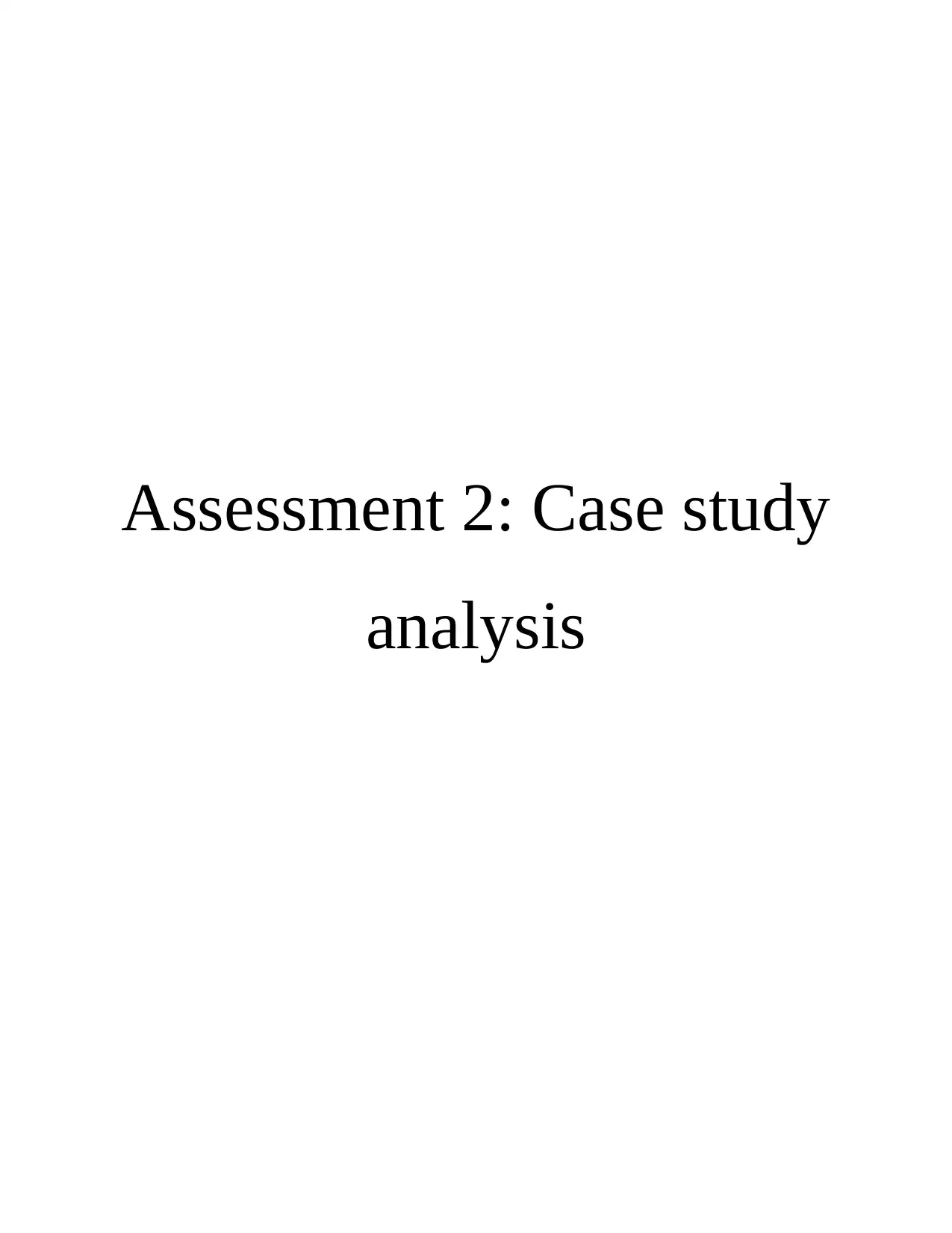
Assessment 2: Case study
analysis
analysis
Paraphrase This Document
Need a fresh take? Get an instant paraphrase of this document with our AI Paraphraser
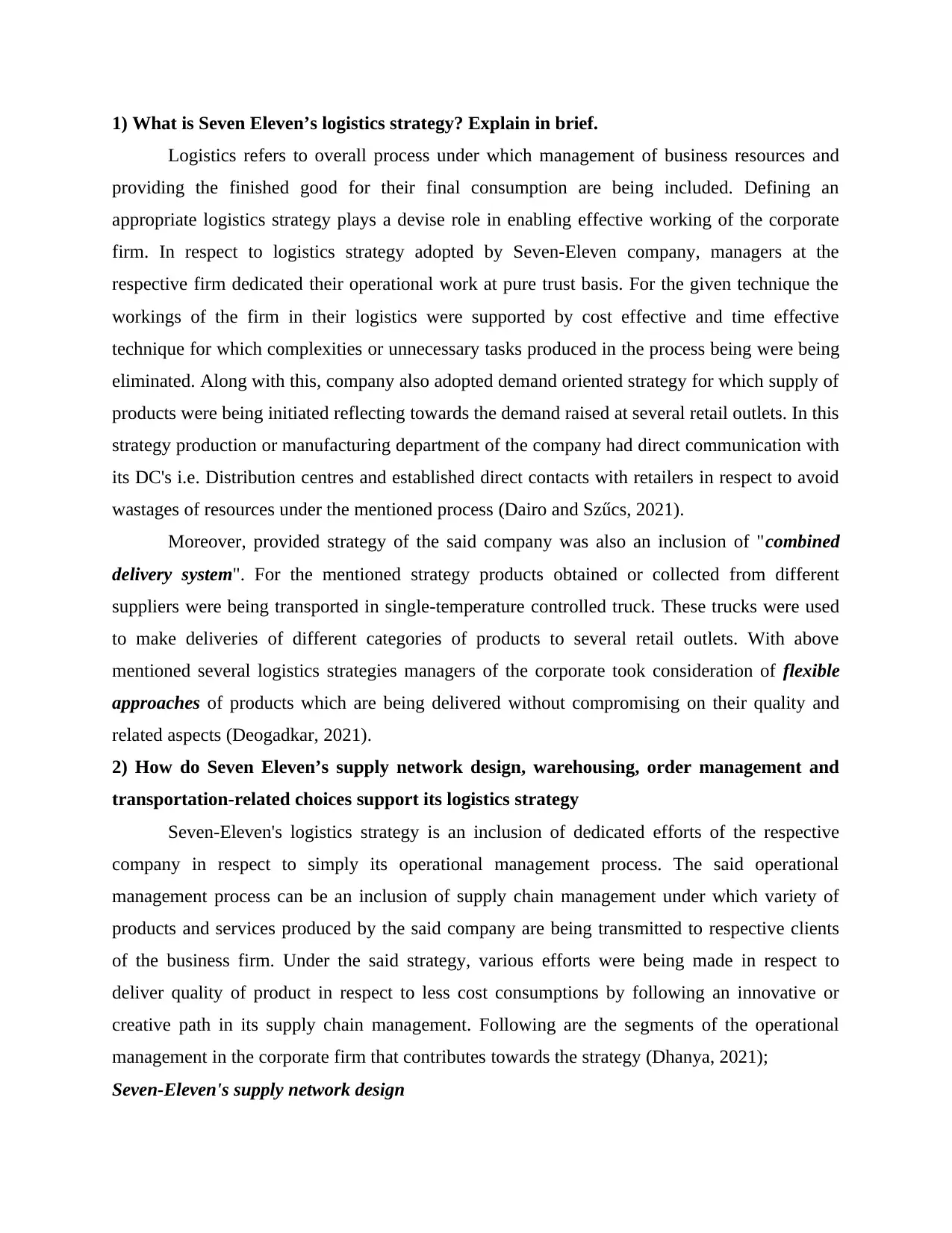
1) What is Seven Eleven’s logistics strategy? Explain in brief.
Logistics refers to overall process under which management of business resources and
providing the finished good for their final consumption are being included. Defining an
appropriate logistics strategy plays a devise role in enabling effective working of the corporate
firm. In respect to logistics strategy adopted by Seven-Eleven company, managers at the
respective firm dedicated their operational work at pure trust basis. For the given technique the
workings of the firm in their logistics were supported by cost effective and time effective
technique for which complexities or unnecessary tasks produced in the process being were being
eliminated. Along with this, company also adopted demand oriented strategy for which supply of
products were being initiated reflecting towards the demand raised at several retail outlets. In this
strategy production or manufacturing department of the company had direct communication with
its DC's i.e. Distribution centres and established direct contacts with retailers in respect to avoid
wastages of resources under the mentioned process (Dairo and Szűcs, 2021).
Moreover, provided strategy of the said company was also an inclusion of "combined
delivery system". For the mentioned strategy products obtained or collected from different
suppliers were being transported in single-temperature controlled truck. These trucks were used
to make deliveries of different categories of products to several retail outlets. With above
mentioned several logistics strategies managers of the corporate took consideration of flexible
approaches of products which are being delivered without compromising on their quality and
related aspects (Deogadkar, 2021).
2) How do Seven Eleven’s supply network design, warehousing, order management and
transportation-related choices support its logistics strategy
Seven-Eleven's logistics strategy is an inclusion of dedicated efforts of the respective
company in respect to simply its operational management process. The said operational
management process can be an inclusion of supply chain management under which variety of
products and services produced by the said company are being transmitted to respective clients
of the business firm. Under the said strategy, various efforts were being made in respect to
deliver quality of product in respect to less cost consumptions by following an innovative or
creative path in its supply chain management. Following are the segments of the operational
management in the corporate firm that contributes towards the strategy (Dhanya, 2021);
Seven-Eleven's supply network design
Logistics refers to overall process under which management of business resources and
providing the finished good for their final consumption are being included. Defining an
appropriate logistics strategy plays a devise role in enabling effective working of the corporate
firm. In respect to logistics strategy adopted by Seven-Eleven company, managers at the
respective firm dedicated their operational work at pure trust basis. For the given technique the
workings of the firm in their logistics were supported by cost effective and time effective
technique for which complexities or unnecessary tasks produced in the process being were being
eliminated. Along with this, company also adopted demand oriented strategy for which supply of
products were being initiated reflecting towards the demand raised at several retail outlets. In this
strategy production or manufacturing department of the company had direct communication with
its DC's i.e. Distribution centres and established direct contacts with retailers in respect to avoid
wastages of resources under the mentioned process (Dairo and Szűcs, 2021).
Moreover, provided strategy of the said company was also an inclusion of "combined
delivery system". For the mentioned strategy products obtained or collected from different
suppliers were being transported in single-temperature controlled truck. These trucks were used
to make deliveries of different categories of products to several retail outlets. With above
mentioned several logistics strategies managers of the corporate took consideration of flexible
approaches of products which are being delivered without compromising on their quality and
related aspects (Deogadkar, 2021).
2) How do Seven Eleven’s supply network design, warehousing, order management and
transportation-related choices support its logistics strategy
Seven-Eleven's logistics strategy is an inclusion of dedicated efforts of the respective
company in respect to simply its operational management process. The said operational
management process can be an inclusion of supply chain management under which variety of
products and services produced by the said company are being transmitted to respective clients
of the business firm. Under the said strategy, various efforts were being made in respect to
deliver quality of product in respect to less cost consumptions by following an innovative or
creative path in its supply chain management. Following are the segments of the operational
management in the corporate firm that contributes towards the strategy (Dhanya, 2021);
Seven-Eleven's supply network design
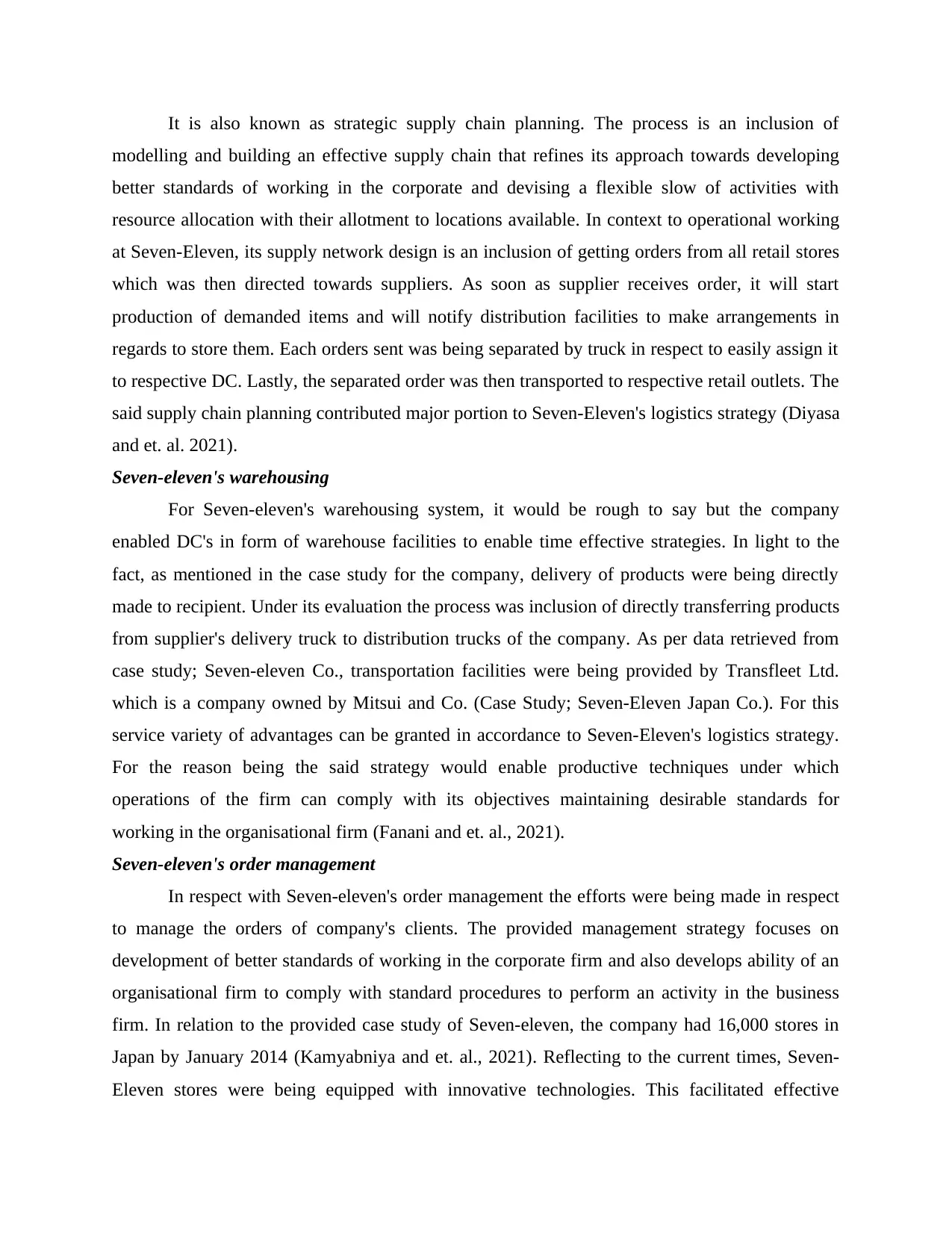
It is also known as strategic supply chain planning. The process is an inclusion of
modelling and building an effective supply chain that refines its approach towards developing
better standards of working in the corporate and devising a flexible slow of activities with
resource allocation with their allotment to locations available. In context to operational working
at Seven-Eleven, its supply network design is an inclusion of getting orders from all retail stores
which was then directed towards suppliers. As soon as supplier receives order, it will start
production of demanded items and will notify distribution facilities to make arrangements in
regards to store them. Each orders sent was being separated by truck in respect to easily assign it
to respective DC. Lastly, the separated order was then transported to respective retail outlets. The
said supply chain planning contributed major portion to Seven-Eleven's logistics strategy (Diyasa
and et. al. 2021).
Seven-eleven's warehousing
For Seven-eleven's warehousing system, it would be rough to say but the company
enabled DC's in form of warehouse facilities to enable time effective strategies. In light to the
fact, as mentioned in the case study for the company, delivery of products were being directly
made to recipient. Under its evaluation the process was inclusion of directly transferring products
from supplier's delivery truck to distribution trucks of the company. As per data retrieved from
case study; Seven-eleven Co., transportation facilities were being provided by Transfleet Ltd.
which is a company owned by Mitsui and Co. (Case Study; Seven-Eleven Japan Co.). For this
service variety of advantages can be granted in accordance to Seven-Eleven's logistics strategy.
For the reason being the said strategy would enable productive techniques under which
operations of the firm can comply with its objectives maintaining desirable standards for
working in the organisational firm (Fanani and et. al., 2021).
Seven-eleven's order management
In respect with Seven-eleven's order management the efforts were being made in respect
to manage the orders of company's clients. The provided management strategy focuses on
development of better standards of working in the corporate firm and also develops ability of an
organisational firm to comply with standard procedures to perform an activity in the business
firm. In relation to the provided case study of Seven-eleven, the company had 16,000 stores in
Japan by January 2014 (Kamyabniya and et. al., 2021). Reflecting to the current times, Seven-
Eleven stores were being equipped with innovative technologies. This facilitated effective
modelling and building an effective supply chain that refines its approach towards developing
better standards of working in the corporate and devising a flexible slow of activities with
resource allocation with their allotment to locations available. In context to operational working
at Seven-Eleven, its supply network design is an inclusion of getting orders from all retail stores
which was then directed towards suppliers. As soon as supplier receives order, it will start
production of demanded items and will notify distribution facilities to make arrangements in
regards to store them. Each orders sent was being separated by truck in respect to easily assign it
to respective DC. Lastly, the separated order was then transported to respective retail outlets. The
said supply chain planning contributed major portion to Seven-Eleven's logistics strategy (Diyasa
and et. al. 2021).
Seven-eleven's warehousing
For Seven-eleven's warehousing system, it would be rough to say but the company
enabled DC's in form of warehouse facilities to enable time effective strategies. In light to the
fact, as mentioned in the case study for the company, delivery of products were being directly
made to recipient. Under its evaluation the process was inclusion of directly transferring products
from supplier's delivery truck to distribution trucks of the company. As per data retrieved from
case study; Seven-eleven Co., transportation facilities were being provided by Transfleet Ltd.
which is a company owned by Mitsui and Co. (Case Study; Seven-Eleven Japan Co.). For this
service variety of advantages can be granted in accordance to Seven-Eleven's logistics strategy.
For the reason being the said strategy would enable productive techniques under which
operations of the firm can comply with its objectives maintaining desirable standards for
working in the organisational firm (Fanani and et. al., 2021).
Seven-eleven's order management
In respect with Seven-eleven's order management the efforts were being made in respect
to manage the orders of company's clients. The provided management strategy focuses on
development of better standards of working in the corporate firm and also develops ability of an
organisational firm to comply with standard procedures to perform an activity in the business
firm. In relation to the provided case study of Seven-eleven, the company had 16,000 stores in
Japan by January 2014 (Kamyabniya and et. al., 2021). Reflecting to the current times, Seven-
Eleven stores were being equipped with innovative technologies. This facilitated effective
⊘ This is a preview!⊘
Do you want full access?
Subscribe today to unlock all pages.

Trusted by 1+ million students worldwide
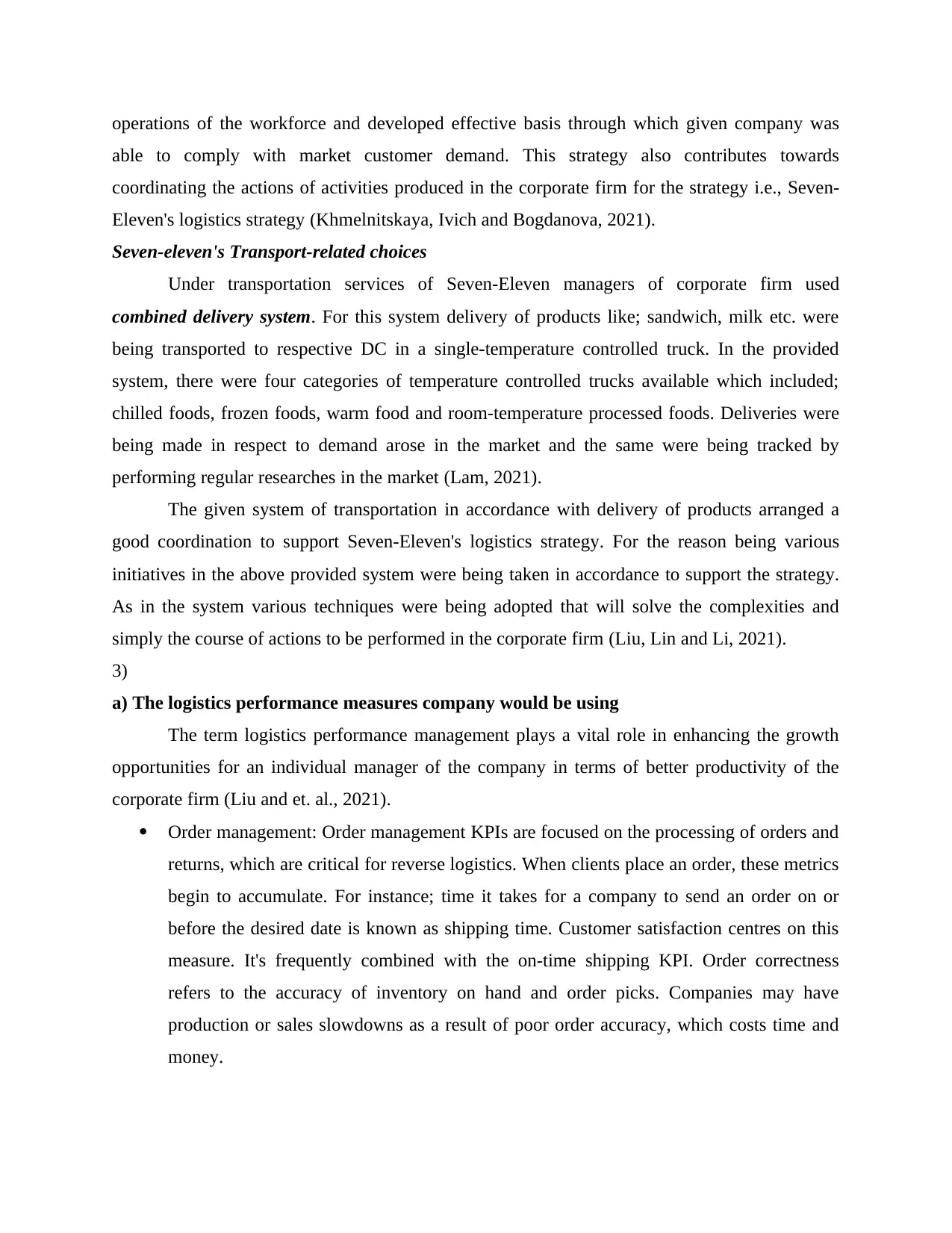
operations of the workforce and developed effective basis through which given company was
able to comply with market customer demand. This strategy also contributes towards
coordinating the actions of activities produced in the corporate firm for the strategy i.e., Seven-
Eleven's logistics strategy (Khmelnitskaya, Ivich and Bogdanova, 2021).
Seven-eleven's Transport-related choices
Under transportation services of Seven-Eleven managers of corporate firm used
combined delivery system. For this system delivery of products like; sandwich, milk etc. were
being transported to respective DC in a single-temperature controlled truck. In the provided
system, there were four categories of temperature controlled trucks available which included;
chilled foods, frozen foods, warm food and room-temperature processed foods. Deliveries were
being made in respect to demand arose in the market and the same were being tracked by
performing regular researches in the market (Lam, 2021).
The given system of transportation in accordance with delivery of products arranged a
good coordination to support Seven-Eleven's logistics strategy. For the reason being various
initiatives in the above provided system were being taken in accordance to support the strategy.
As in the system various techniques were being adopted that will solve the complexities and
simply the course of actions to be performed in the corporate firm (Liu, Lin and Li, 2021).
3)
a) The logistics performance measures company would be using
The term logistics performance management plays a vital role in enhancing the growth
opportunities for an individual manager of the company in terms of better productivity of the
corporate firm (Liu and et. al., 2021).
Order management: Order management KPIs are focused on the processing of orders and
returns, which are critical for reverse logistics. When clients place an order, these metrics
begin to accumulate. For instance; time it takes for a company to send an order on or
before the desired date is known as shipping time. Customer satisfaction centres on this
measure. It's frequently combined with the on-time shipping KPI. Order correctness
refers to the accuracy of inventory on hand and order picks. Companies may have
production or sales slowdowns as a result of poor order accuracy, which costs time and
money.
able to comply with market customer demand. This strategy also contributes towards
coordinating the actions of activities produced in the corporate firm for the strategy i.e., Seven-
Eleven's logistics strategy (Khmelnitskaya, Ivich and Bogdanova, 2021).
Seven-eleven's Transport-related choices
Under transportation services of Seven-Eleven managers of corporate firm used
combined delivery system. For this system delivery of products like; sandwich, milk etc. were
being transported to respective DC in a single-temperature controlled truck. In the provided
system, there were four categories of temperature controlled trucks available which included;
chilled foods, frozen foods, warm food and room-temperature processed foods. Deliveries were
being made in respect to demand arose in the market and the same were being tracked by
performing regular researches in the market (Lam, 2021).
The given system of transportation in accordance with delivery of products arranged a
good coordination to support Seven-Eleven's logistics strategy. For the reason being various
initiatives in the above provided system were being taken in accordance to support the strategy.
As in the system various techniques were being adopted that will solve the complexities and
simply the course of actions to be performed in the corporate firm (Liu, Lin and Li, 2021).
3)
a) The logistics performance measures company would be using
The term logistics performance management plays a vital role in enhancing the growth
opportunities for an individual manager of the company in terms of better productivity of the
corporate firm (Liu and et. al., 2021).
Order management: Order management KPIs are focused on the processing of orders and
returns, which are critical for reverse logistics. When clients place an order, these metrics
begin to accumulate. For instance; time it takes for a company to send an order on or
before the desired date is known as shipping time. Customer satisfaction centres on this
measure. It's frequently combined with the on-time shipping KPI. Order correctness
refers to the accuracy of inventory on hand and order picks. Companies may have
production or sales slowdowns as a result of poor order accuracy, which costs time and
money.
Paraphrase This Document
Need a fresh take? Get an instant paraphrase of this document with our AI Paraphraser
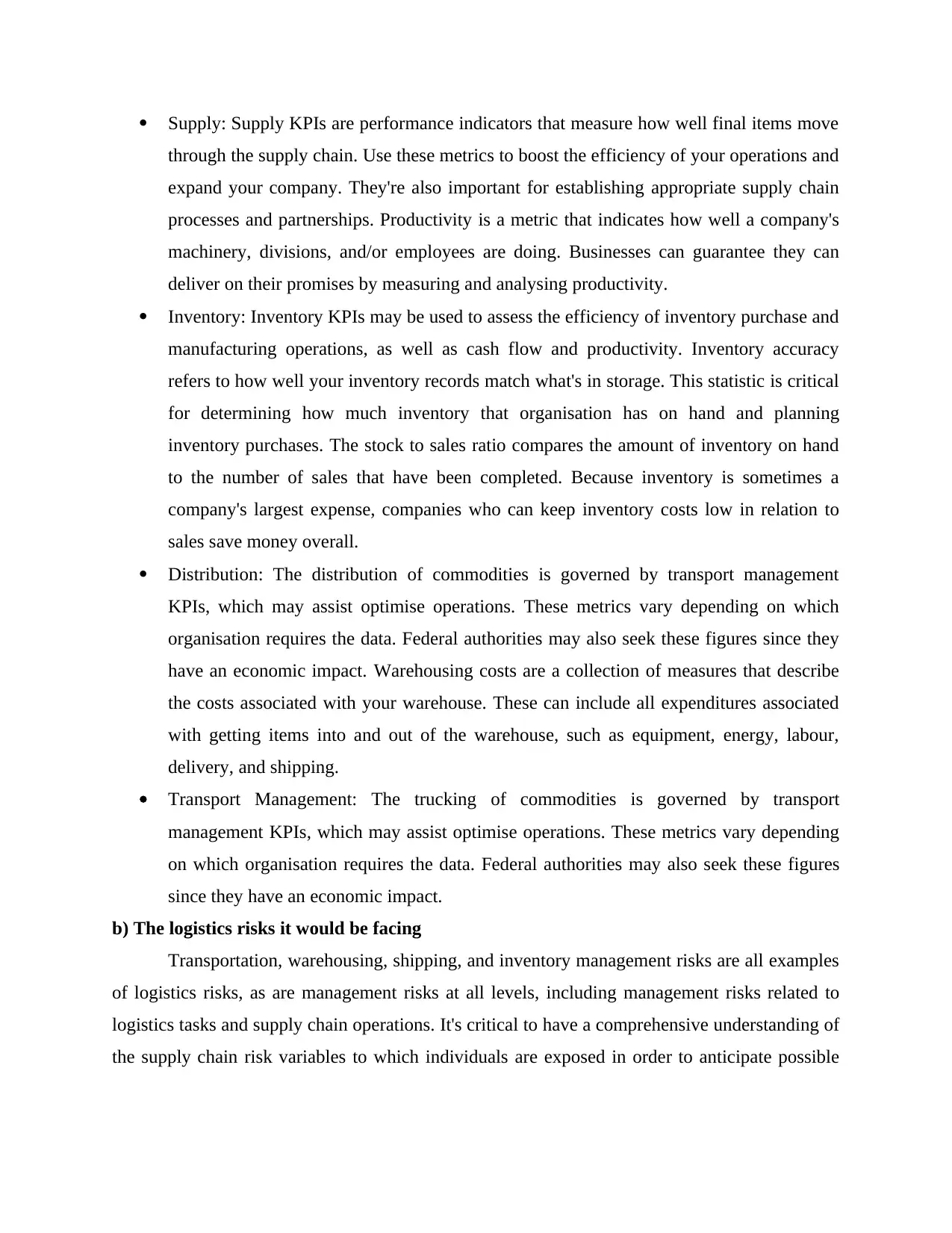
Supply: Supply KPIs are performance indicators that measure how well final items move
through the supply chain. Use these metrics to boost the efficiency of your operations and
expand your company. They're also important for establishing appropriate supply chain
processes and partnerships. Productivity is a metric that indicates how well a company's
machinery, divisions, and/or employees are doing. Businesses can guarantee they can
deliver on their promises by measuring and analysing productivity.
Inventory: Inventory KPIs may be used to assess the efficiency of inventory purchase and
manufacturing operations, as well as cash flow and productivity. Inventory accuracy
refers to how well your inventory records match what's in storage. This statistic is critical
for determining how much inventory that organisation has on hand and planning
inventory purchases. The stock to sales ratio compares the amount of inventory on hand
to the number of sales that have been completed. Because inventory is sometimes a
company's largest expense, companies who can keep inventory costs low in relation to
sales save money overall.
Distribution: The distribution of commodities is governed by transport management
KPIs, which may assist optimise operations. These metrics vary depending on which
organisation requires the data. Federal authorities may also seek these figures since they
have an economic impact. Warehousing costs are a collection of measures that describe
the costs associated with your warehouse. These can include all expenditures associated
with getting items into and out of the warehouse, such as equipment, energy, labour,
delivery, and shipping.
Transport Management: The trucking of commodities is governed by transport
management KPIs, which may assist optimise operations. These metrics vary depending
on which organisation requires the data. Federal authorities may also seek these figures
since they have an economic impact.
b) The logistics risks it would be facing
Transportation, warehousing, shipping, and inventory management risks are all examples
of logistics risks, as are management risks at all levels, including management risks related to
logistics tasks and supply chain operations. It's critical to have a comprehensive understanding of
the supply chain risk variables to which individuals are exposed in order to anticipate possible
through the supply chain. Use these metrics to boost the efficiency of your operations and
expand your company. They're also important for establishing appropriate supply chain
processes and partnerships. Productivity is a metric that indicates how well a company's
machinery, divisions, and/or employees are doing. Businesses can guarantee they can
deliver on their promises by measuring and analysing productivity.
Inventory: Inventory KPIs may be used to assess the efficiency of inventory purchase and
manufacturing operations, as well as cash flow and productivity. Inventory accuracy
refers to how well your inventory records match what's in storage. This statistic is critical
for determining how much inventory that organisation has on hand and planning
inventory purchases. The stock to sales ratio compares the amount of inventory on hand
to the number of sales that have been completed. Because inventory is sometimes a
company's largest expense, companies who can keep inventory costs low in relation to
sales save money overall.
Distribution: The distribution of commodities is governed by transport management
KPIs, which may assist optimise operations. These metrics vary depending on which
organisation requires the data. Federal authorities may also seek these figures since they
have an economic impact. Warehousing costs are a collection of measures that describe
the costs associated with your warehouse. These can include all expenditures associated
with getting items into and out of the warehouse, such as equipment, energy, labour,
delivery, and shipping.
Transport Management: The trucking of commodities is governed by transport
management KPIs, which may assist optimise operations. These metrics vary depending
on which organisation requires the data. Federal authorities may also seek these figures
since they have an economic impact.
b) The logistics risks it would be facing
Transportation, warehousing, shipping, and inventory management risks are all examples
of logistics risks, as are management risks at all levels, including management risks related to
logistics tasks and supply chain operations. It's critical to have a comprehensive understanding of
the supply chain risk variables to which individuals are exposed in order to anticipate possible
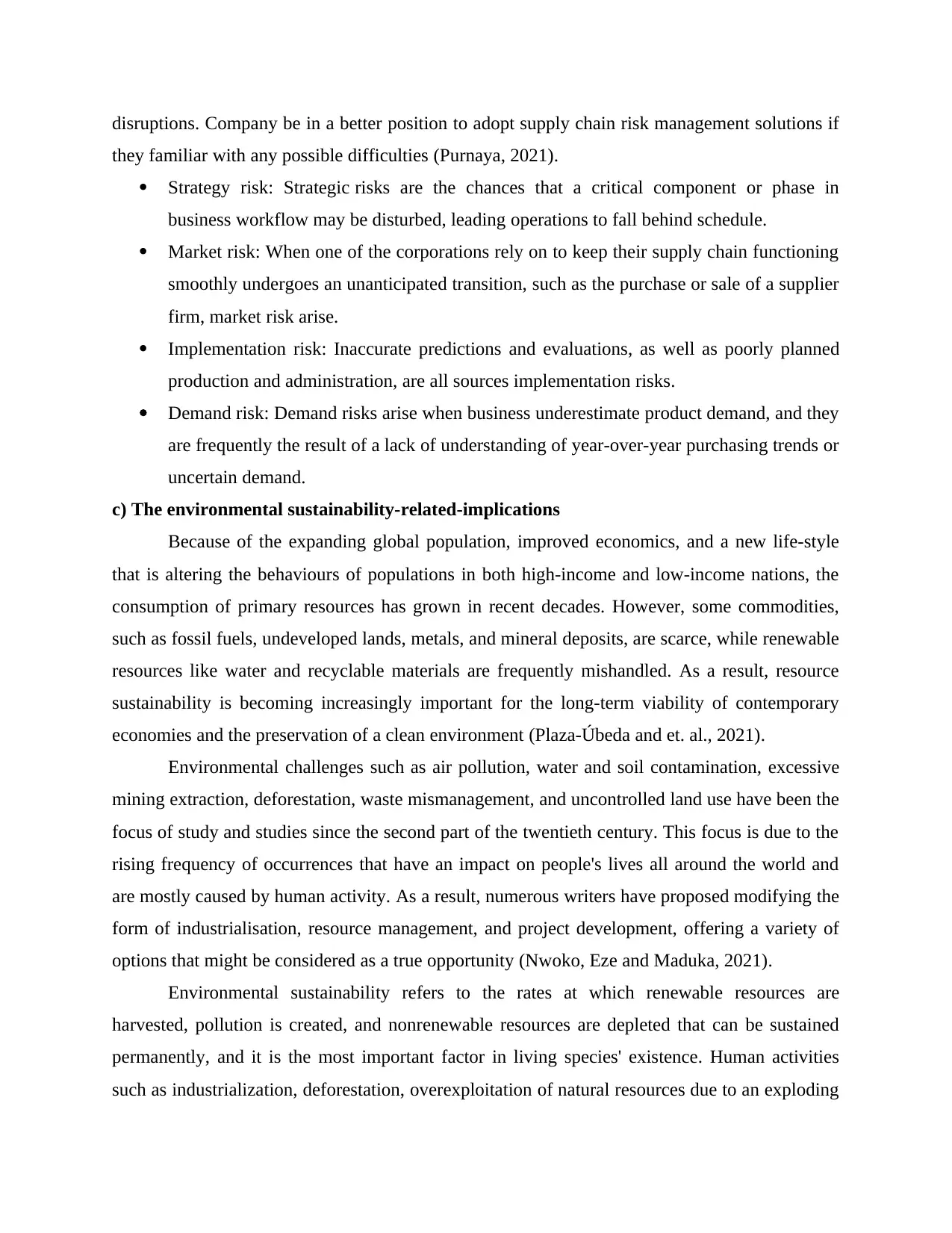
disruptions. Company be in a better position to adopt supply chain risk management solutions if
they familiar with any possible difficulties (Purnaya, 2021).
Strategy risk: Strategic risks are the chances that a critical component or phase in
business workflow may be disturbed, leading operations to fall behind schedule.
Market risk: When one of the corporations rely on to keep their supply chain functioning
smoothly undergoes an unanticipated transition, such as the purchase or sale of a supplier
firm, market risk arise.
Implementation risk: Inaccurate predictions and evaluations, as well as poorly planned
production and administration, are all sources implementation risks.
Demand risk: Demand risks arise when business underestimate product demand, and they
are frequently the result of a lack of understanding of year-over-year purchasing trends or
uncertain demand.
c) The environmental sustainability-related-implications
Because of the expanding global population, improved economics, and a new life-style
that is altering the behaviours of populations in both high-income and low-income nations, the
consumption of primary resources has grown in recent decades. However, some commodities,
such as fossil fuels, undeveloped lands, metals, and mineral deposits, are scarce, while renewable
resources like water and recyclable materials are frequently mishandled. As a result, resource
sustainability is becoming increasingly important for the long-term viability of contemporary
economies and the preservation of a clean environment (Plaza-Úbeda and et. al., 2021).
Environmental challenges such as air pollution, water and soil contamination, excessive
mining extraction, deforestation, waste mismanagement, and uncontrolled land use have been the
focus of study and studies since the second part of the twentieth century. This focus is due to the
rising frequency of occurrences that have an impact on people's lives all around the world and
are mostly caused by human activity. As a result, numerous writers have proposed modifying the
form of industrialisation, resource management, and project development, offering a variety of
options that might be considered as a true opportunity (Nwoko, Eze and Maduka, 2021).
Environmental sustainability refers to the rates at which renewable resources are
harvested, pollution is created, and nonrenewable resources are depleted that can be sustained
permanently, and it is the most important factor in living species' existence. Human activities
such as industrialization, deforestation, overexploitation of natural resources due to an exploding
they familiar with any possible difficulties (Purnaya, 2021).
Strategy risk: Strategic risks are the chances that a critical component or phase in
business workflow may be disturbed, leading operations to fall behind schedule.
Market risk: When one of the corporations rely on to keep their supply chain functioning
smoothly undergoes an unanticipated transition, such as the purchase or sale of a supplier
firm, market risk arise.
Implementation risk: Inaccurate predictions and evaluations, as well as poorly planned
production and administration, are all sources implementation risks.
Demand risk: Demand risks arise when business underestimate product demand, and they
are frequently the result of a lack of understanding of year-over-year purchasing trends or
uncertain demand.
c) The environmental sustainability-related-implications
Because of the expanding global population, improved economics, and a new life-style
that is altering the behaviours of populations in both high-income and low-income nations, the
consumption of primary resources has grown in recent decades. However, some commodities,
such as fossil fuels, undeveloped lands, metals, and mineral deposits, are scarce, while renewable
resources like water and recyclable materials are frequently mishandled. As a result, resource
sustainability is becoming increasingly important for the long-term viability of contemporary
economies and the preservation of a clean environment (Plaza-Úbeda and et. al., 2021).
Environmental challenges such as air pollution, water and soil contamination, excessive
mining extraction, deforestation, waste mismanagement, and uncontrolled land use have been the
focus of study and studies since the second part of the twentieth century. This focus is due to the
rising frequency of occurrences that have an impact on people's lives all around the world and
are mostly caused by human activity. As a result, numerous writers have proposed modifying the
form of industrialisation, resource management, and project development, offering a variety of
options that might be considered as a true opportunity (Nwoko, Eze and Maduka, 2021).
Environmental sustainability refers to the rates at which renewable resources are
harvested, pollution is created, and nonrenewable resources are depleted that can be sustained
permanently, and it is the most important factor in living species' existence. Human activities
such as industrialization, deforestation, overexploitation of natural resources due to an exploding
⊘ This is a preview!⊘
Do you want full access?
Subscribe today to unlock all pages.

Trusted by 1+ million students worldwide
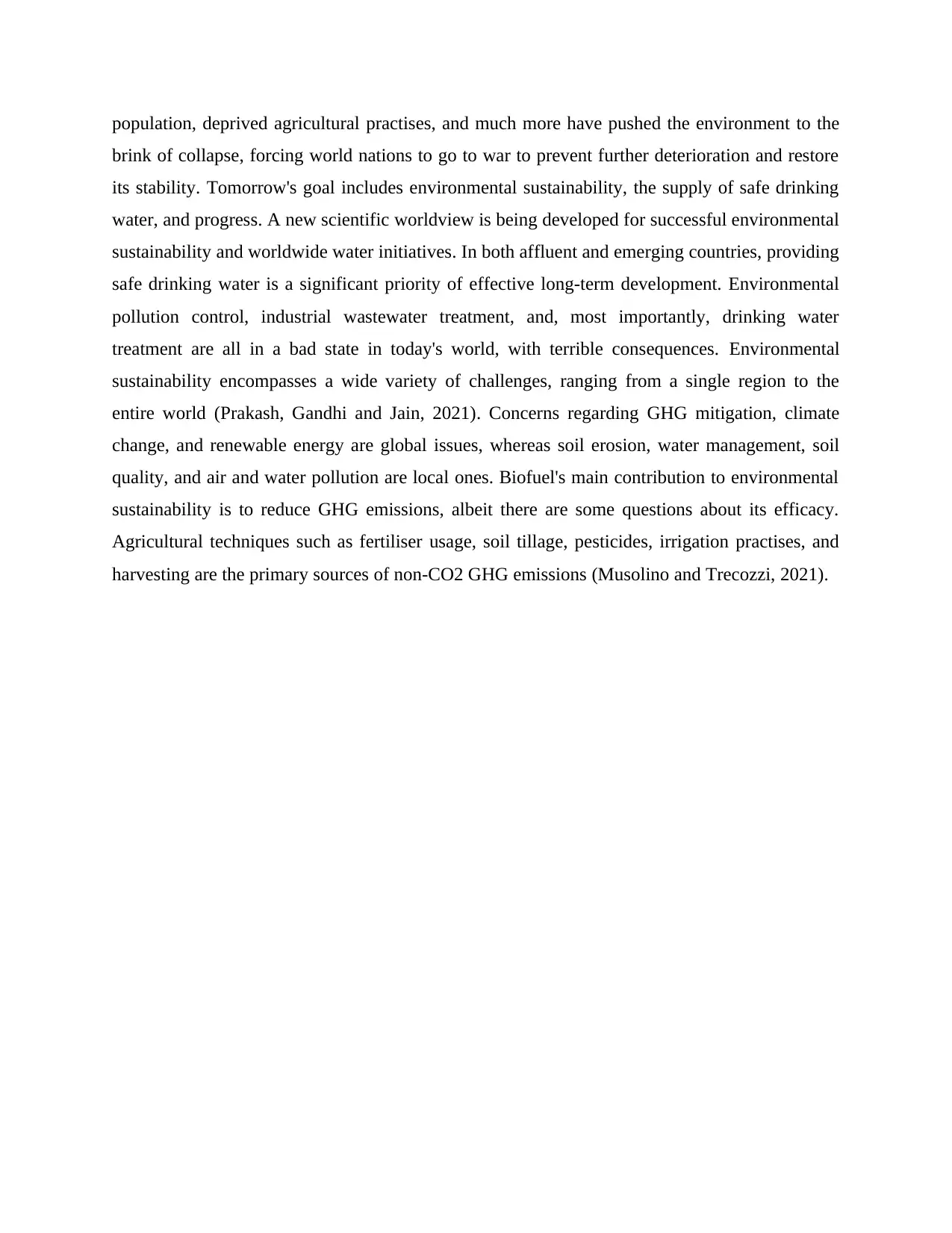
population, deprived agricultural practises, and much more have pushed the environment to the
brink of collapse, forcing world nations to go to war to prevent further deterioration and restore
its stability. Tomorrow's goal includes environmental sustainability, the supply of safe drinking
water, and progress. A new scientific worldview is being developed for successful environmental
sustainability and worldwide water initiatives. In both affluent and emerging countries, providing
safe drinking water is a significant priority of effective long-term development. Environmental
pollution control, industrial wastewater treatment, and, most importantly, drinking water
treatment are all in a bad state in today's world, with terrible consequences. Environmental
sustainability encompasses a wide variety of challenges, ranging from a single region to the
entire world (Prakash, Gandhi and Jain, 2021). Concerns regarding GHG mitigation, climate
change, and renewable energy are global issues, whereas soil erosion, water management, soil
quality, and air and water pollution are local ones. Biofuel's main contribution to environmental
sustainability is to reduce GHG emissions, albeit there are some questions about its efficacy.
Agricultural techniques such as fertiliser usage, soil tillage, pesticides, irrigation practises, and
harvesting are the primary sources of non-CO2 GHG emissions (Musolino and Trecozzi, 2021).
brink of collapse, forcing world nations to go to war to prevent further deterioration and restore
its stability. Tomorrow's goal includes environmental sustainability, the supply of safe drinking
water, and progress. A new scientific worldview is being developed for successful environmental
sustainability and worldwide water initiatives. In both affluent and emerging countries, providing
safe drinking water is a significant priority of effective long-term development. Environmental
pollution control, industrial wastewater treatment, and, most importantly, drinking water
treatment are all in a bad state in today's world, with terrible consequences. Environmental
sustainability encompasses a wide variety of challenges, ranging from a single region to the
entire world (Prakash, Gandhi and Jain, 2021). Concerns regarding GHG mitigation, climate
change, and renewable energy are global issues, whereas soil erosion, water management, soil
quality, and air and water pollution are local ones. Biofuel's main contribution to environmental
sustainability is to reduce GHG emissions, albeit there are some questions about its efficacy.
Agricultural techniques such as fertiliser usage, soil tillage, pesticides, irrigation practises, and
harvesting are the primary sources of non-CO2 GHG emissions (Musolino and Trecozzi, 2021).
Paraphrase This Document
Need a fresh take? Get an instant paraphrase of this document with our AI Paraphraser
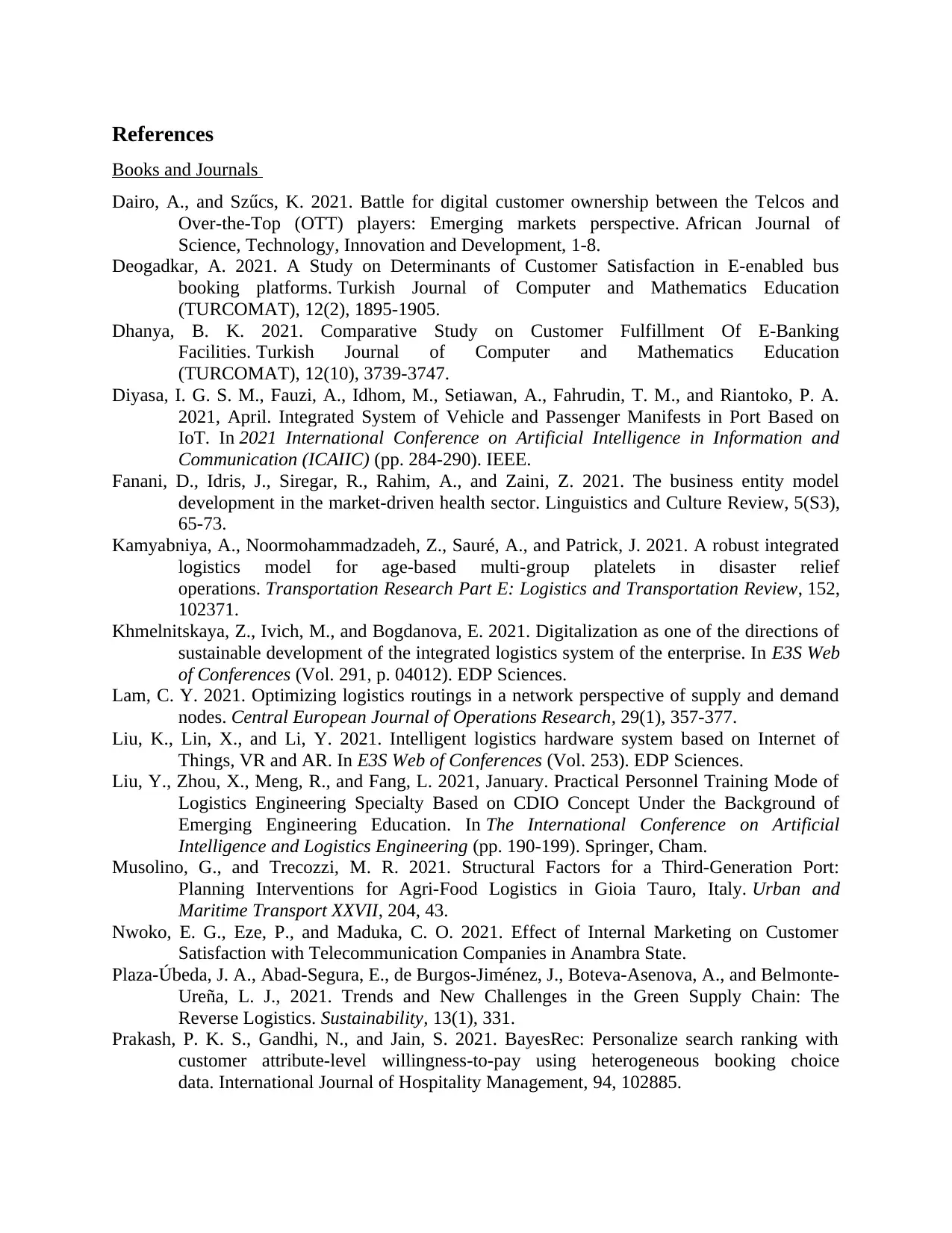
References
Books and Journals
Dairo, A., and Szűcs, K. 2021. Battle for digital customer ownership between the Telcos and
Over-the-Top (OTT) players: Emerging markets perspective. African Journal of
Science, Technology, Innovation and Development, 1-8.
Deogadkar, A. 2021. A Study on Determinants of Customer Satisfaction in E-enabled bus
booking platforms. Turkish Journal of Computer and Mathematics Education
(TURCOMAT), 12(2), 1895-1905.
Dhanya, B. K. 2021. Comparative Study on Customer Fulfillment Of E-Banking
Facilities. Turkish Journal of Computer and Mathematics Education
(TURCOMAT), 12(10), 3739-3747.
Diyasa, I. G. S. M., Fauzi, A., Idhom, M., Setiawan, A., Fahrudin, T. M., and Riantoko, P. A.
2021, April. Integrated System of Vehicle and Passenger Manifests in Port Based on
IoT. In 2021 International Conference on Artificial Intelligence in Information and
Communication (ICAIIC) (pp. 284-290). IEEE.
Fanani, D., Idris, J., Siregar, R., Rahim, A., and Zaini, Z. 2021. The business entity model
development in the market-driven health sector. Linguistics and Culture Review, 5(S3),
65-73.
Kamyabniya, A., Noormohammadzadeh, Z., Sauré, A., and Patrick, J. 2021. A robust integrated
logistics model for age-based multi-group platelets in disaster relief
operations. Transportation Research Part E: Logistics and Transportation Review, 152,
102371.
Khmelnitskaya, Z., Ivich, M., and Bogdanova, E. 2021. Digitalization as one of the directions of
sustainable development of the integrated logistics system of the enterprise. In E3S Web
of Conferences (Vol. 291, p. 04012). EDP Sciences.
Lam, C. Y. 2021. Optimizing logistics routings in a network perspective of supply and demand
nodes. Central European Journal of Operations Research, 29(1), 357-377.
Liu, K., Lin, X., and Li, Y. 2021. Intelligent logistics hardware system based on Internet of
Things, VR and AR. In E3S Web of Conferences (Vol. 253). EDP Sciences.
Liu, Y., Zhou, X., Meng, R., and Fang, L. 2021, January. Practical Personnel Training Mode of
Logistics Engineering Specialty Based on CDIO Concept Under the Background of
Emerging Engineering Education. In The International Conference on Artificial
Intelligence and Logistics Engineering (pp. 190-199). Springer, Cham.
Musolino, G., and Trecozzi, M. R. 2021. Structural Factors for a Third-Generation Port:
Planning Interventions for Agri-Food Logistics in Gioia Tauro, Italy. Urban and
Maritime Transport XXVII, 204, 43.
Nwoko, E. G., Eze, P., and Maduka, C. O. 2021. Effect of Internal Marketing on Customer
Satisfaction with Telecommunication Companies in Anambra State.
Plaza-Úbeda, J. A., Abad-Segura, E., de Burgos-Jiménez, J., Boteva-Asenova, A., and Belmonte-
Ureña, L. J., 2021. Trends and New Challenges in the Green Supply Chain: The
Reverse Logistics. Sustainability, 13(1), 331.
Prakash, P. K. S., Gandhi, N., and Jain, S. 2021. BayesRec: Personalize search ranking with
customer attribute-level willingness-to-pay using heterogeneous booking choice
data. International Journal of Hospitality Management, 94, 102885.
Books and Journals
Dairo, A., and Szűcs, K. 2021. Battle for digital customer ownership between the Telcos and
Over-the-Top (OTT) players: Emerging markets perspective. African Journal of
Science, Technology, Innovation and Development, 1-8.
Deogadkar, A. 2021. A Study on Determinants of Customer Satisfaction in E-enabled bus
booking platforms. Turkish Journal of Computer and Mathematics Education
(TURCOMAT), 12(2), 1895-1905.
Dhanya, B. K. 2021. Comparative Study on Customer Fulfillment Of E-Banking
Facilities. Turkish Journal of Computer and Mathematics Education
(TURCOMAT), 12(10), 3739-3747.
Diyasa, I. G. S. M., Fauzi, A., Idhom, M., Setiawan, A., Fahrudin, T. M., and Riantoko, P. A.
2021, April. Integrated System of Vehicle and Passenger Manifests in Port Based on
IoT. In 2021 International Conference on Artificial Intelligence in Information and
Communication (ICAIIC) (pp. 284-290). IEEE.
Fanani, D., Idris, J., Siregar, R., Rahim, A., and Zaini, Z. 2021. The business entity model
development in the market-driven health sector. Linguistics and Culture Review, 5(S3),
65-73.
Kamyabniya, A., Noormohammadzadeh, Z., Sauré, A., and Patrick, J. 2021. A robust integrated
logistics model for age-based multi-group platelets in disaster relief
operations. Transportation Research Part E: Logistics and Transportation Review, 152,
102371.
Khmelnitskaya, Z., Ivich, M., and Bogdanova, E. 2021. Digitalization as one of the directions of
sustainable development of the integrated logistics system of the enterprise. In E3S Web
of Conferences (Vol. 291, p. 04012). EDP Sciences.
Lam, C. Y. 2021. Optimizing logistics routings in a network perspective of supply and demand
nodes. Central European Journal of Operations Research, 29(1), 357-377.
Liu, K., Lin, X., and Li, Y. 2021. Intelligent logistics hardware system based on Internet of
Things, VR and AR. In E3S Web of Conferences (Vol. 253). EDP Sciences.
Liu, Y., Zhou, X., Meng, R., and Fang, L. 2021, January. Practical Personnel Training Mode of
Logistics Engineering Specialty Based on CDIO Concept Under the Background of
Emerging Engineering Education. In The International Conference on Artificial
Intelligence and Logistics Engineering (pp. 190-199). Springer, Cham.
Musolino, G., and Trecozzi, M. R. 2021. Structural Factors for a Third-Generation Port:
Planning Interventions for Agri-Food Logistics in Gioia Tauro, Italy. Urban and
Maritime Transport XXVII, 204, 43.
Nwoko, E. G., Eze, P., and Maduka, C. O. 2021. Effect of Internal Marketing on Customer
Satisfaction with Telecommunication Companies in Anambra State.
Plaza-Úbeda, J. A., Abad-Segura, E., de Burgos-Jiménez, J., Boteva-Asenova, A., and Belmonte-
Ureña, L. J., 2021. Trends and New Challenges in the Green Supply Chain: The
Reverse Logistics. Sustainability, 13(1), 331.
Prakash, P. K. S., Gandhi, N., and Jain, S. 2021. BayesRec: Personalize search ranking with
customer attribute-level willingness-to-pay using heterogeneous booking choice
data. International Journal of Hospitality Management, 94, 102885.

Purnaya, I. N. 2021, July. Logistics 4.0 and The Implication to Society 5.0. In KaPIN
Conference (pp. 229-234).
Conference (pp. 229-234).
⊘ This is a preview!⊘
Do you want full access?
Subscribe today to unlock all pages.

Trusted by 1+ million students worldwide
1 out of 9
Related Documents
Your All-in-One AI-Powered Toolkit for Academic Success.
+13062052269
info@desklib.com
Available 24*7 on WhatsApp / Email
![[object Object]](/_next/static/media/star-bottom.7253800d.svg)
Unlock your academic potential
Copyright © 2020–2025 A2Z Services. All Rights Reserved. Developed and managed by ZUCOL.





